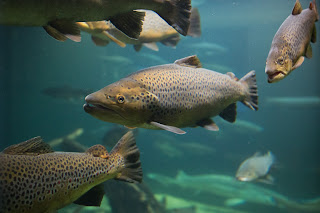Aquabyte
recently announced the completion of its series B financing of US$25
million, led by SoftBank Ventures Asia. Aquabyte, which uses computer
vision and artificial intelligence (AI) to give fish farms insight into
the health and growth of their fish, says that the funding will be used
to continue its mission of transforming aquaculture to meeting growing
global demand for sustainable protein.
By
2050, it is estimated that there will be a 50 percent protein gap
worldwide, and farmed fish is the most sustainable and efficient protein
source to fill that gap. Aquabyte has built international,
cross-disciplinary teams working in fish welfare, AI and engineering,
using practices drawn from salmon farms in Norway.
"Before
Aquabyte, it was virtually impossible for fish farms to monitor the
health of their underwater fish," explains Bryton Shang, Founder and CEO
of Aquabyte. "Our engineering team solved that problem with a smart
underwater camera that can accurately detect lice, monitor other welfare
indicators, and identify and weigh individual fish without removing
them from the water."
"Our
fish welfare biologists work with our AI teams to transform those
images and underwater signals into real-time data … Farms can take
immediate action to improve the health and growth of their fish with
less waste and fewer treatments," Mr Shang adds.
Sherman
Li, Partner at SoftBank Ventures Asia, expressed that he was "proud" to
be supporting Aquabyte in their journey. "By combining machine learning
and computer vision with fish welfare insights, Aquabyte is leading a
transformation in the aquaculture and food industry," he says.
The Nature Conservancy and Westerly Wind also joined the round as new investors.
"We firmly believe embracing technology is the solution for a more sustainable future," explains Karim Abdel-Ghaffar Plaza, Managing Partner at Westerly Winds. "Aquabyte in our opinion is a clear leader, enabling the path towards a healthier aquaculture industry needed to feed the growing world population. We're tremendously excited to be backing the team and business in the years to come."
Original
investors New Enterprise Associates, Costanoa Ventures, ArcTern
Ventures, Struck Capital and Alliance Venture participated in the round
as they pointed out Aquabyte's achievements since its Series A funding
in 2019.
Since
the funding, the company now has hundreds of systems installed
worldwide monitoring salmon and trout, established offices in the US,
Norway and Chile, has processed over 300 million fish images, and was
the first to receive approval for automatic sea lice counting by the
Norwegian Food Safety Authorities.
"Mass
market appeal and the potential for positive global impact make for
very exciting investment opportunities – Aquabyte has both," says Greg
Papadopoulos, Venture Partner at NEA. "We're thrilled to continue
partnering with the Aquabyte team to go through this next phase of
growth."
With
this Series B round of funding, Aquabyte has raised a total of US$46
million since its founding in 2017. It will use the financing to scale
its business, to monitor more species in more countries and help fish
farms sustainably feed the world.
"It
turns out that when you improve fish welfare and sustainability, you
solve problems in efficiency as well," concludes Mr Shang.
For more information on Aquabyte visit their website, HERE.

















